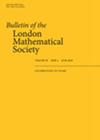下载PDF
{"title":"特征p$ p$的动态丢番图近似指数","authors":"Wade Hindes","doi":"10.1112/blms.13168","DOIUrl":null,"url":null,"abstract":"<p>Let <span></span><math>\n <semantics>\n <mrow>\n <mi>ϕ</mi>\n <mo>(</mo>\n <mi>z</mi>\n <mo>)</mo>\n </mrow>\n <annotation>$\\phi (z)$</annotation>\n </semantics></math> be a non-isotrivial rational function in one-variable with coefficients in <span></span><math>\n <semantics>\n <mrow>\n <msub>\n <mover>\n <mi>F</mi>\n <mo>¯</mo>\n </mover>\n <mi>p</mi>\n </msub>\n <mrow>\n <mo>(</mo>\n <mi>t</mi>\n <mo>)</mo>\n </mrow>\n </mrow>\n <annotation>$\\overline{\\mathbb {F}}_p(t)$</annotation>\n </semantics></math> and assume that <span></span><math>\n <semantics>\n <mrow>\n <mi>γ</mi>\n <mo>∈</mo>\n <msup>\n <mi>P</mi>\n <mn>1</mn>\n </msup>\n <mrow>\n <mo>(</mo>\n <msub>\n <mover>\n <mi>F</mi>\n <mo>¯</mo>\n </mover>\n <mi>p</mi>\n </msub>\n <mrow>\n <mo>(</mo>\n <mi>t</mi>\n <mo>)</mo>\n </mrow>\n <mo>)</mo>\n </mrow>\n </mrow>\n <annotation>$\\gamma \\in \\mathbb {P}^1(\\overline{\\mathbb {F}}_p(t))$</annotation>\n </semantics></math> is not a post-critical point for <span></span><math>\n <semantics>\n <mi>ϕ</mi>\n <annotation>$\\phi$</annotation>\n </semantics></math>. Then we prove that the diophantine approximation exponent of elements of <span></span><math>\n <semantics>\n <mrow>\n <msup>\n <mi>ϕ</mi>\n <mrow>\n <mo>−</mo>\n <mi>m</mi>\n </mrow>\n </msup>\n <mrow>\n <mo>(</mo>\n <mi>γ</mi>\n <mo>)</mo>\n </mrow>\n </mrow>\n <annotation>$\\phi ^{-m}(\\gamma)$</annotation>\n </semantics></math> are eventually bounded above by <span></span><math>\n <semantics>\n <mrow>\n <mo>⌈</mo>\n <mo>deg</mo>\n <msup>\n <mrow>\n <mo>(</mo>\n <mi>ϕ</mi>\n <mo>)</mo>\n </mrow>\n <mi>m</mi>\n </msup>\n <mo>/</mo>\n <mn>2</mn>\n <mo>⌉</mo>\n <mo>+</mo>\n <mn>1</mn>\n </mrow>\n <annotation>$\\lceil \\deg (\\phi)^m/2\\rceil +1$</annotation>\n </semantics></math>. To do this, we mix diophantine techniques in characteristic <span></span><math>\n <semantics>\n <mi>p</mi>\n <annotation>$p$</annotation>\n </semantics></math> with the adelic equidistribution of small points in Berkovich space. As an application, we deduce a form of Silverman's celebrated limit theorem in this setting. Namely, if we take any wandering point <span></span><math>\n <semantics>\n <mrow>\n <mi>a</mi>\n <mo>∈</mo>\n <msup>\n <mi>P</mi>\n <mn>1</mn>\n </msup>\n <mrow>\n <mo>(</mo>\n <msub>\n <mover>\n <mi>F</mi>\n <mo>¯</mo>\n </mover>\n <mi>p</mi>\n </msub>\n <mrow>\n <mo>(</mo>\n <mi>t</mi>\n <mo>)</mo>\n </mrow>\n <mo>)</mo>\n </mrow>\n </mrow>\n <annotation>$a\\in \\mathbb {P}^1(\\overline{\\mathbb {F}}_p(t))$</annotation>\n </semantics></math> and write <span></span><math>\n <semantics>\n <mrow>\n <msup>\n <mi>ϕ</mi>\n <mi>n</mi>\n </msup>\n <mrow>\n <mo>(</mo>\n <mi>a</mi>\n <mo>)</mo>\n </mrow>\n <mo>=</mo>\n <msub>\n <mi>a</mi>\n <mi>n</mi>\n </msub>\n <mo>/</mo>\n <msub>\n <mi>b</mi>\n <mi>n</mi>\n </msub>\n </mrow>\n <annotation>$\\phi ^n(a)=a_n/b_n$</annotation>\n </semantics></math> for some coprime polynomials <span></span><math>\n <semantics>\n <mrow>\n <msub>\n <mi>a</mi>\n <mi>n</mi>\n </msub>\n <mo>,</mo>\n <msub>\n <mi>b</mi>\n <mi>n</mi>\n </msub>\n <mo>∈</mo>\n <msub>\n <mover>\n <mi>F</mi>\n <mo>¯</mo>\n </mover>\n <mi>p</mi>\n </msub>\n <mrow>\n <mo>[</mo>\n <mi>t</mi>\n <mo>]</mo>\n </mrow>\n </mrow>\n <annotation>$a_n,b_n\\in \\overline{\\mathbb {F}}_p[t]$</annotation>\n </semantics></math>, then we prove that\n\n </p>","PeriodicalId":55298,"journal":{"name":"Bulletin of the London Mathematical Society","volume":"56 12","pages":"3801-3818"},"PeriodicalIF":0.8000,"publicationDate":"2024-10-17","publicationTypes":"Journal Article","fieldsOfStudy":null,"isOpenAccess":false,"openAccessPdf":"https://onlinelibrary.wiley.com/doi/epdf/10.1112/blms.13168","citationCount":"0","resultStr":"{\"title\":\"Dynamical diophantine approximation exponents in characteristic \\n \\n p\\n $p$\",\"authors\":\"Wade Hindes\",\"doi\":\"10.1112/blms.13168\",\"DOIUrl\":null,\"url\":null,\"abstract\":\"<p>Let <span></span><math>\\n <semantics>\\n <mrow>\\n <mi>ϕ</mi>\\n <mo>(</mo>\\n <mi>z</mi>\\n <mo>)</mo>\\n </mrow>\\n <annotation>$\\\\phi (z)$</annotation>\\n </semantics></math> be a non-isotrivial rational function in one-variable with coefficients in <span></span><math>\\n <semantics>\\n <mrow>\\n <msub>\\n <mover>\\n <mi>F</mi>\\n <mo>¯</mo>\\n </mover>\\n <mi>p</mi>\\n </msub>\\n <mrow>\\n <mo>(</mo>\\n <mi>t</mi>\\n <mo>)</mo>\\n </mrow>\\n </mrow>\\n <annotation>$\\\\overline{\\\\mathbb {F}}_p(t)$</annotation>\\n </semantics></math> and assume that <span></span><math>\\n <semantics>\\n <mrow>\\n <mi>γ</mi>\\n <mo>∈</mo>\\n <msup>\\n <mi>P</mi>\\n <mn>1</mn>\\n </msup>\\n <mrow>\\n <mo>(</mo>\\n <msub>\\n <mover>\\n <mi>F</mi>\\n <mo>¯</mo>\\n </mover>\\n <mi>p</mi>\\n </msub>\\n <mrow>\\n <mo>(</mo>\\n <mi>t</mi>\\n <mo>)</mo>\\n </mrow>\\n <mo>)</mo>\\n </mrow>\\n </mrow>\\n <annotation>$\\\\gamma \\\\in \\\\mathbb {P}^1(\\\\overline{\\\\mathbb {F}}_p(t))$</annotation>\\n </semantics></math> is not a post-critical point for <span></span><math>\\n <semantics>\\n <mi>ϕ</mi>\\n <annotation>$\\\\phi$</annotation>\\n </semantics></math>. Then we prove that the diophantine approximation exponent of elements of <span></span><math>\\n <semantics>\\n <mrow>\\n <msup>\\n <mi>ϕ</mi>\\n <mrow>\\n <mo>−</mo>\\n <mi>m</mi>\\n </mrow>\\n </msup>\\n <mrow>\\n <mo>(</mo>\\n <mi>γ</mi>\\n <mo>)</mo>\\n </mrow>\\n </mrow>\\n <annotation>$\\\\phi ^{-m}(\\\\gamma)$</annotation>\\n </semantics></math> are eventually bounded above by <span></span><math>\\n <semantics>\\n <mrow>\\n <mo>⌈</mo>\\n <mo>deg</mo>\\n <msup>\\n <mrow>\\n <mo>(</mo>\\n <mi>ϕ</mi>\\n <mo>)</mo>\\n </mrow>\\n <mi>m</mi>\\n </msup>\\n <mo>/</mo>\\n <mn>2</mn>\\n <mo>⌉</mo>\\n <mo>+</mo>\\n <mn>1</mn>\\n </mrow>\\n <annotation>$\\\\lceil \\\\deg (\\\\phi)^m/2\\\\rceil +1$</annotation>\\n </semantics></math>. To do this, we mix diophantine techniques in characteristic <span></span><math>\\n <semantics>\\n <mi>p</mi>\\n <annotation>$p$</annotation>\\n </semantics></math> with the adelic equidistribution of small points in Berkovich space. As an application, we deduce a form of Silverman's celebrated limit theorem in this setting. Namely, if we take any wandering point <span></span><math>\\n <semantics>\\n <mrow>\\n <mi>a</mi>\\n <mo>∈</mo>\\n <msup>\\n <mi>P</mi>\\n <mn>1</mn>\\n </msup>\\n <mrow>\\n <mo>(</mo>\\n <msub>\\n <mover>\\n <mi>F</mi>\\n <mo>¯</mo>\\n </mover>\\n <mi>p</mi>\\n </msub>\\n <mrow>\\n <mo>(</mo>\\n <mi>t</mi>\\n <mo>)</mo>\\n </mrow>\\n <mo>)</mo>\\n </mrow>\\n </mrow>\\n <annotation>$a\\\\in \\\\mathbb {P}^1(\\\\overline{\\\\mathbb {F}}_p(t))$</annotation>\\n </semantics></math> and write <span></span><math>\\n <semantics>\\n <mrow>\\n <msup>\\n <mi>ϕ</mi>\\n <mi>n</mi>\\n </msup>\\n <mrow>\\n <mo>(</mo>\\n <mi>a</mi>\\n <mo>)</mo>\\n </mrow>\\n <mo>=</mo>\\n <msub>\\n <mi>a</mi>\\n <mi>n</mi>\\n </msub>\\n <mo>/</mo>\\n <msub>\\n <mi>b</mi>\\n <mi>n</mi>\\n </msub>\\n </mrow>\\n <annotation>$\\\\phi ^n(a)=a_n/b_n$</annotation>\\n </semantics></math> for some coprime polynomials <span></span><math>\\n <semantics>\\n <mrow>\\n <msub>\\n <mi>a</mi>\\n <mi>n</mi>\\n </msub>\\n <mo>,</mo>\\n <msub>\\n <mi>b</mi>\\n <mi>n</mi>\\n </msub>\\n <mo>∈</mo>\\n <msub>\\n <mover>\\n <mi>F</mi>\\n <mo>¯</mo>\\n </mover>\\n <mi>p</mi>\\n </msub>\\n <mrow>\\n <mo>[</mo>\\n <mi>t</mi>\\n <mo>]</mo>\\n </mrow>\\n </mrow>\\n <annotation>$a_n,b_n\\\\in \\\\overline{\\\\mathbb {F}}_p[t]$</annotation>\\n </semantics></math>, then we prove that\\n\\n </p>\",\"PeriodicalId\":55298,\"journal\":{\"name\":\"Bulletin of the London Mathematical Society\",\"volume\":\"56 12\",\"pages\":\"3801-3818\"},\"PeriodicalIF\":0.8000,\"publicationDate\":\"2024-10-17\",\"publicationTypes\":\"Journal Article\",\"fieldsOfStudy\":null,\"isOpenAccess\":false,\"openAccessPdf\":\"https://onlinelibrary.wiley.com/doi/epdf/10.1112/blms.13168\",\"citationCount\":\"0\",\"resultStr\":null,\"platform\":\"Semanticscholar\",\"paperid\":null,\"PeriodicalName\":\"Bulletin of the London Mathematical Society\",\"FirstCategoryId\":\"100\",\"ListUrlMain\":\"https://onlinelibrary.wiley.com/doi/10.1112/blms.13168\",\"RegionNum\":3,\"RegionCategory\":\"数学\",\"ArticlePicture\":[],\"TitleCN\":null,\"AbstractTextCN\":null,\"PMCID\":null,\"EPubDate\":\"\",\"PubModel\":\"\",\"JCR\":\"Q2\",\"JCRName\":\"MATHEMATICS\",\"Score\":null,\"Total\":0}","platform":"Semanticscholar","paperid":null,"PeriodicalName":"Bulletin of the London Mathematical Society","FirstCategoryId":"100","ListUrlMain":"https://onlinelibrary.wiley.com/doi/10.1112/blms.13168","RegionNum":3,"RegionCategory":"数学","ArticlePicture":[],"TitleCN":null,"AbstractTextCN":null,"PMCID":null,"EPubDate":"","PubModel":"","JCR":"Q2","JCRName":"MATHEMATICS","Score":null,"Total":0}
引用次数: 0
引用
批量引用

 求助内容:
求助内容: 应助结果提醒方式:
应助结果提醒方式:


